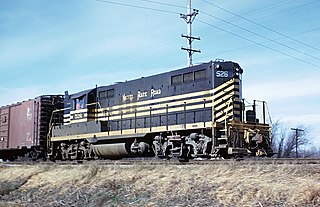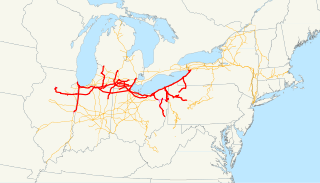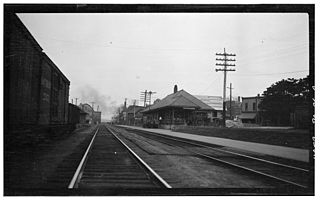
The New York Central Railroad was a railroad primarily operating in the Great Lakes and Mid-Atlantic regions of the United States. The railroad primarily connected greater New York and Boston in the east with Chicago and St. Louis in the Midwest along with the intermediate cities of Albany, Buffalo, Cleveland, Cincinnati, Detroit, and Syracuse. New York Central was headquartered in New York City's New York Central Building, adjacent to its largest station, Grand Central Terminal.
The Erie Railroad was a railroad that operated in the northeastern United States, originally connecting New York City — more specifically Jersey City, New Jersey, where Erie's Pavonia Terminal, long demolished, used to stand — with Lake Erie. It expanded west to Chicago with its 1941 merger with the former Atlantic and Great Western Railroad, also known as the New York, Pennsylvania and Ohio Railroad. Its mainline route proved influential in the development and economic growth of the Southern Tier of New York State, including cities such as Binghamton, Elmira, and Hornell. The Erie Railroad repair shops were located in Hornell and was Hornell's largest employer. Hornell was also where Erie's mainline split into two routes, one north to Buffalo and the other west to Cleveland.

The New York, Chicago and St. Louis Railroad, abbreviated NYC&St.L, was a railroad that operated in the mid-central United States. Commonly referred to as the "Nickel Plate Road", the railroad served a large area, including trackage in the states of New York, Pennsylvania, Ohio, Indiana, Illinois, and Missouri. Its primary connections included Buffalo, Chicago, Cincinnati, Cleveland, Indianapolis, St. Louis, and Toledo.

The Lake Shore and Michigan Southern Railway, established in 1833 and sometimes referred to as the Lake Shore, was a major part of the New York Central Railroad's Water Level Route from Buffalo, New York, to Chicago, Illinois, primarily along the south shore of Lake Erie and across northern Indiana. The line's trackage is still used as a major rail transportation corridor and hosts Amtrak passenger trains, with the ownership in 1998 split at Cleveland between CSX to the east, and Norfolk Southern in the west.

The Chicago and Eastern Illinois Railroad was a Class I railroad that linked Chicago to southern Illinois, St. Louis, and Evansville. Founded in 1877, it grew aggressively and stayed relatively strong throughout the Great Depression and two World Wars before finally being purchased by the Missouri Pacific Railroad and the Louisville and Nashville Railroad (L&N). Missouri Pacific merged with the C&EI corporate entity in 1976, and was later acquired itself by the Union Pacific Railroad.

The Pittsburgh, Cincinnati, Chicago and St. Louis Railroad, commonly called the Pan Handle Route, was a railroad that was part of the Pennsylvania Railroad system. Its common name came from its main line, which began at Pittsburgh, Pennsylvania, crossed the Northern Panhandle of West Virginia, and continued west to Bradford, Ohio, where it split into a northern line to Chicago and a southern one through Indianapolis, Indiana, to East St. Louis, Illinois.

The Pennsylvania Company, later known publicly as the Pennsylvania Lines was a major holding company. It included the Pittsburgh, Fort Wayne and Chicago Railway, the PRR's main route to Chicago. It also owned but did not operate the Pittsburgh, Cincinnati, Chicago and St. Louis Railroad, another line to Chicago. It merged back into the Pennsylvania Railroad in 1918.
The Northeast U.S. and the Great Lakes states are connected by an east-west railroad corridor. The endpoints of this corridor are New York City and Chicago. Along the way, the corridor passed through cities such as Philadelphia, Baltimore, Washington, D.C., Pittsburgh, Buffalo and Cleveland. There were branches off the corridor to cities such as Cincinnati, Detroit, Indianapolis, and St. Louis. For over a century, this corridor was dominated by four major railroads, and an aggregate of other railroads that served as a fifth option.

Railroads have been vital in the history of the population and trade of rough and finished goods in the state of Michigan. While some coastal settlements had previously existed, the population, commercial, and industrial growth of the state further bloomed with the establishment of the railroad.

The Terre Haute, Indianapolis and Eastern Traction Company, or THI&E, was the second largest interurban in the U.S. state of Indiana at the 1920s height of the "interurban era." This system included over 400 miles of track, with lines radiating from Indianapolis to the east, northwest, west and southwest as well as streetcar lines in several major cities. The THI&E was formed in 1907 by the Schoepf-McGowan Syndicate as a combination of several predecessor interurban and street car companies and was operated independently until incorporation into the Indiana Railroad in 1931. The THI&E served a wide range of territory, including farmlands in central Indiana, the mining region around Brazil, and numerous urban centers. Eventually it slowly succumbed, like all of the other central Indiana interurban lines, to competition from automobiles and trucks and improved paralleling highways.
The Atlantic and Great Western Railroad began as three separate railroads: the Erie and New York City Railroad based in Jamestown, New York; the Meadville Railroad based in Meadville, Pennsylvania ; and the Franklin and Warren Railroad based in Franklin Mills, Ohio. The owners of the three railroads had been working closely together since an October 8, 1852, meeting in Cleveland to plan an expansion of the "Great Broad Route", the Erie Railroad, through their respective areas.
A. A. Talmadge, born Archibald Alexander Talmadge, was a 19th-century vice-president and general manager of the Wabash Railroad. Born in Warren County, New Jersey, of Scottish descent, his father was a Presbyterian minister. He worked in a country store in Goshen, New York, for several years beginning when he was fifteen. At the age of eighteen, Talmadge was appointed clerk in the freight department of the New York and Erie Railroad, where he remained for a year. He worked for a hardware wholesale firm on Dey Street in New York City afterward. During the winter of 1854, Talmadge moved to Chicago, Illinois, where he found employment as a clerk in the freight department of the Michigan Southern Railroad.
The Baltimore and Ohio and Chicago Railroad (B&O&C) was a subsidiary of the Baltimore and Ohio Railroad (B&O) that owned the line from Willard, Ohio to Chicago, Illinois.

The Lake Cities was a passenger train operated by the Erie Railroad and successor Erie Lackawanna Railway between Chicago and New Jersey termini — first, Jersey City and later Hoboken.

The James Whitcomb Riley was a passenger train that operated between Chicago, Illinois, and Cincinnati, Ohio, via Indianapolis, Indiana. Originally operated by the New York Central Railroad, it was taken over by Amtrak in 1971. Under Amtrak, it merged with the Chesapeake & Ohio Railroad's George Washington to become a Chicago-Washington/Newport News train. In 1977, it was renamed the Cardinal, which remains in operation.

The Wabash Railroad was a Class I railroad that operated in the mid-central United States. It served a large area, including track in the states of Ohio, Indiana, Illinois, Iowa, Michigan, and Missouri and the province of Ontario. Its primary connections included Chicago, Illinois; Kansas City, Missouri; Detroit, Michigan; Buffalo, New York; St. Louis, Missouri; and Toledo, Ohio.
The Fremont and Indiana Railroad existed in Northwest Ohio beginning in 1853.

Cambridge Springs was a railroad station for the Erie Railroad in Cambridge Springs, Crawford County, Pennsylvania, United States. Cambridge Springs station was on the Main Line's Meadville Division, which was the section of the line between Salamanca, New York, and Meadville, Pennsylvania. The station was located 501.2 miles (806.6 km) from Manhattan and the Barclay Street Ferry, which connected to Pavonia Terminal in Jersey City, New Jersey, and 480.8 miles (773.8 km) from Hoboken Terminal in Hoboken, New Jersey. For nearly three decades, the station had connections to the Northwestern Pennsylvania Railway, which was a trolley line that connected the city of Erie and Meadville. Modern Erie Railroad station signage denoted the station as "Home of Alliance College," a local private university that closed in 1987.

Salamanca was a railroad station for the Erie Railroad in Salamanca, New York, United States. The station was located at 137 Main Street in Salamanca, across the track from the Buffalo, Rochester and Pittsburgh Railway depot. Located as the terminus of the Meadville Division of the Erie Railroad main line, Salamanca was considered part of the Allegany Division, which went between Dunkirk and Hornell.

The Cleveland and Mahoning Valley Railroad (C&MV) was a shortline railroad operating in the state of Ohio in the United States. Originally known as the Cleveland and Mahoning Railroad (C&M), it was chartered in 1848. Construction of the line began in 1853 and was completed in 1857. After an 1872 merger with two small railroads, the corporate name was changed to "Cleveland and Mahoning Valley Railroad". The railroad leased itself to the Atlantic and Great Western Railway in 1863. The C&MV suffered financial instability, and in 1880 its stock was sold to a company based in London in the United Kingdom. A series of leases and ownership changes left the C&MV in the hands of the Erie Railroad in 1896. The CM&V's corporate identity ended in 1942 after the Erie Railroad completed purchasing the railroad's outstanding stock from the British investors.














